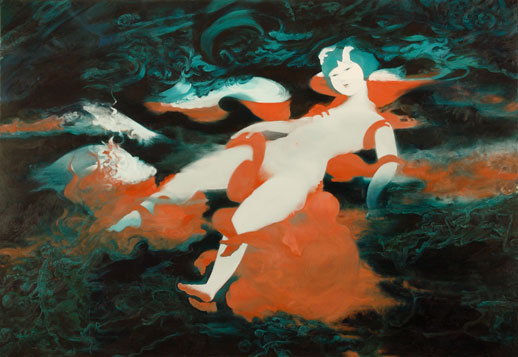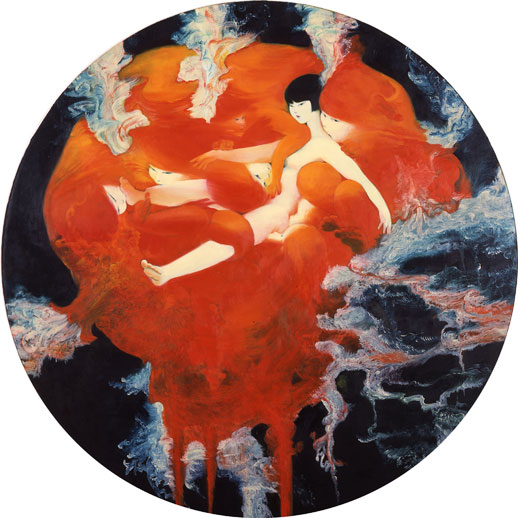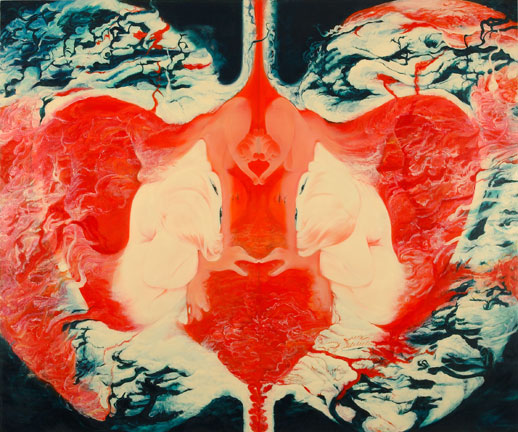At Home in an Uncertain Pool
A girl with bobbed hair lies back in a dark and uncertain pool. One look at the hands feeling their way around her forehead suggests that she succumbed to this state some time ago. Her head is tilted ever-so-slightly to one side and we can all understand the feeling of someone caressing her neck. Likewise, we are with this mysterious girl as she gradually lets go. However, something is nibbling away at her thigh.

The girl’s name is Eiko, a character that Akino Kondoh has drawn and painted since she was eighteen. Taking centre stage in her acclaimed animations, Eiko has all the hallmarks of a child, a heroine, or an adventurer (in the mould of Alice in Wonderland) Yet, for all the fantastical imagery that one may associate with her animations, Kondoh’s shift towards painting places Eiko in a world that is far darker, a world that alludes to 18th and 19th century romanticists.
The basic structure of an animation is simply a sequence of one drawing after another in which the depth of each image remains the same. Each moment replaces the previous one in the mind of the viewer leaving little in the way of traces. Therefore, having admitted that animation lacked presence, Kondoh turned to oil painting in an attempt to show something that the animations could not. This more malleable medium offered the opportunity to show many moments at one time, presenting a previously unseen depth to her chosen world, where the layers are fused and not substituted. The result is a darker and more intriguing place. In the animations, there was a sense that the girl (as did Alice in the animated version of Alice in Wonderland) would never come to actual harm. Yet in these paintings- based upon the relationship between humans and plants- Eiko is vulnerable and we not only see this but we share it.

The exhibition features eight paintings of various sizes and in all but two we are part of an audience watching a play. For example, in Flesh and Kanro, Eiko is theatrically placed at the centre of the canvas, her smoky surroundings forming limbs, hands, and heads that engulf her. Kondoh’s animations would have placed the emphasis on such movement, whereas these paintings merely suggest it — drawn in by Kondoh’s sensitive handling of the medium, I found myself fixed to the spot. Something was persuading me to stay and watch but in doing so, I could almost feel the gnawing teeth of those smoky beings on my own skin.
These paintings, through their theatrical compositions, confirmed my role as a member of its audience; a witness to a tragic play, but the two remaining paintings made me feel differently. These two large paintings, titled Fruit and Seed, decentralize Eiko; her image is presented in reflection across a vertical axis running through the centre of the paintings. In this state of reflection and confusion that goes against the centralized compositions of the others, I was brought crashing down from the prestigious position of witness and left to contemplate both my relationship to the painting and Eiko’s relationship with herself and her surroundings. The drama of the other paintings stop here and we really begin to relate to Eiko’s (or the artist’s) state of mind.

The artist has acknowledged an interest in Rorschach tests and symmetry found in nature, and their influence on these particular compositions stand out significantly. They reminded me of something Hegel taught, and what Jacques Rancière reminds us of in his book The Future of the Image that: “Its [art’s] presence is always in two places at once.” In Kondoh’s paintings, what she seeks lies not just in the layers of oil paint applied over time but also implicates the viewer; the audience is involved in a way that they could perhaps never be in her animations. It is not surprising that Kondoh remains inspired by John Everett Millais’ Ophelia, which so successfully mastered the art of telling a story in just one picture. Those who appreciate Kondoh’s works the most will most likely be romanticists themselves, lovers of stories and narrative.
For now, Kondoh is turning her back on animation, a medium grounded in spectacle, and embracing instead oil painting, a medium of duration, trapping Eiko in a world of Blake-esque shadows and Turneresque hazes. However, given that Kondoh has spoken of inspiration for a new animation, it may not be long before Eiko leaves this eerie world. If she does, I for one, feel that it could well be a shame. She does after all, despite being gnawed at, look very much at home.
—
1 Rancière, J., trans. Elliot, G (2007) The Future of the Image, Verso. p.89.
Gary McLeod
Gary McLeod



